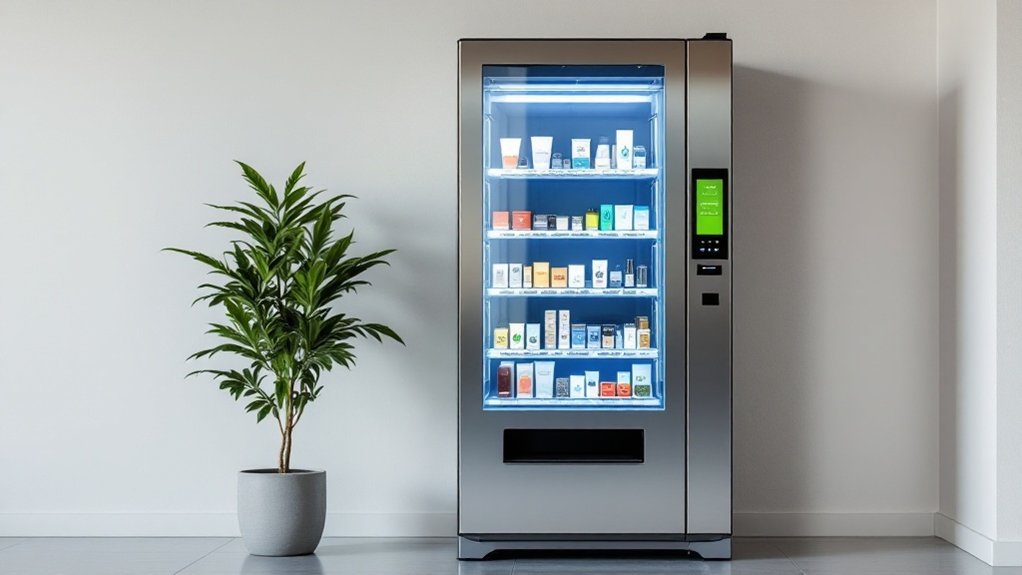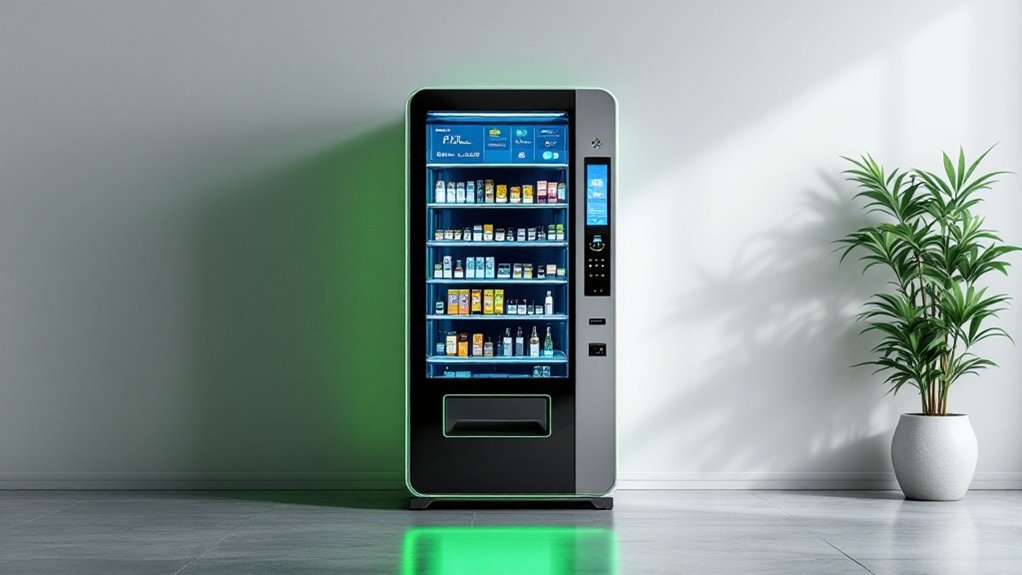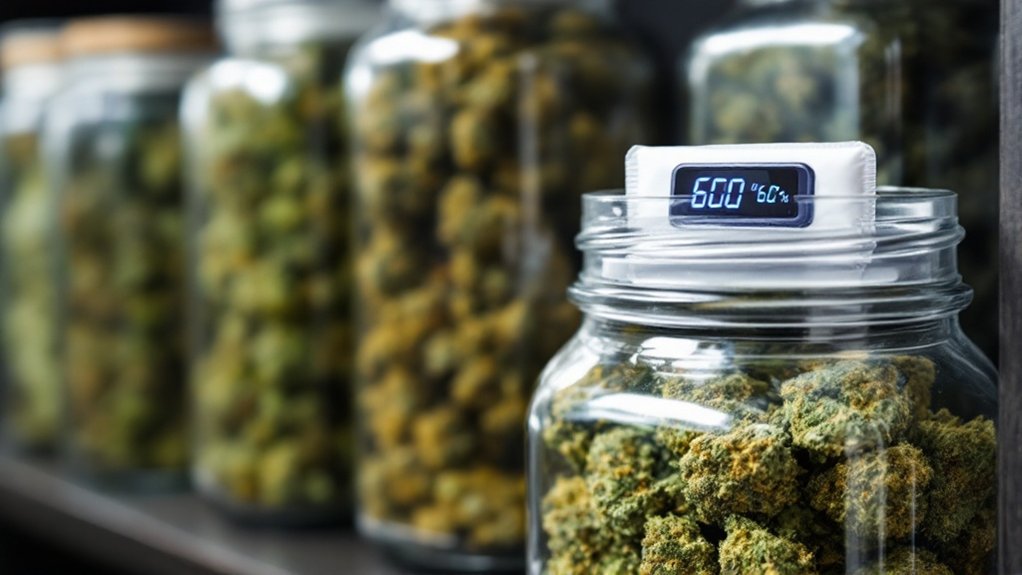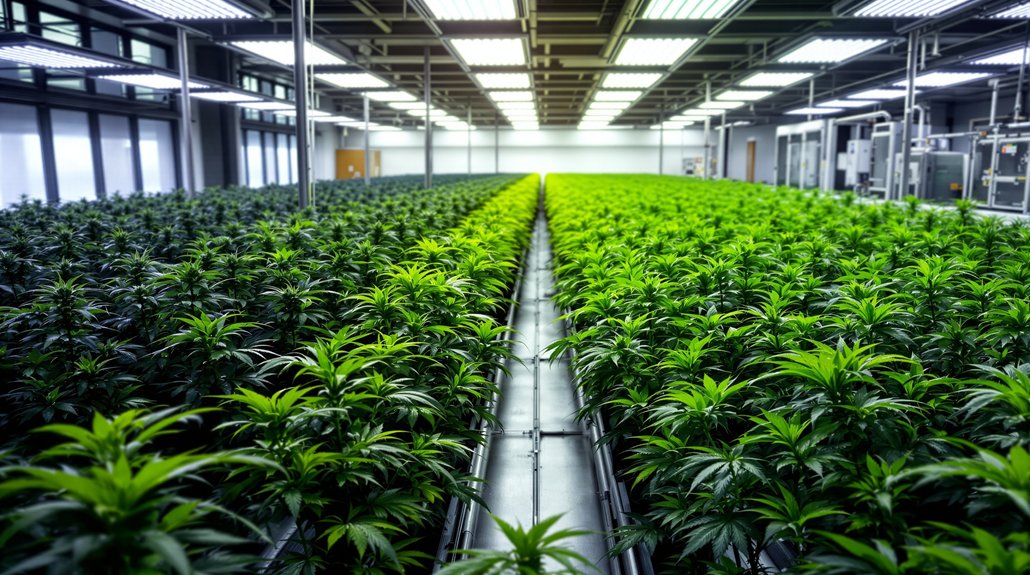Launching a cannabis vending machine business requires maneuvering complex regulations across 38 states with varying legality. The industry, valued at $0.5 billion, is projected to hit $1.5 billion by 2030, a juicy 15% CAGR. Entrepreneurs need age verification tech, security systems, and competitive positioning against traditional dispensaries. Banking restrictions? Yep, those too. Costs are high, but automation reduces operational expenses. The compliance headaches might be worth it for those ready to tackle this growing market.

Every entrepreneur looking for the next big thing might want to contemplate the booming cannabis vending machine industry. Currently valued at a modest $0.5 billion, this market is projected to triple to $1.5 billion by 2030, growing at a robust 15% CAGR. That’s not small potatoes.
Cannabis vending machines: a half-billion dollar niche set to triple by 2030. Not your average growth industry.
When compared to the overall cannabis market, expected to hit $100 billion by 2026, vending machines represent a specialized niche with serious growth potential.
These aren’t your grandpa’s snack dispensers. The market offers several machine types: standard THC dispensers, CBD-only units for the wellness crowd, medical-only machines requiring prescriptions, hybrid options, and even mini-kiosks for nightclubs. Each comes equipped with age verification technology.
The regulatory landscape is complex but promising. With 38 states allowing medical cannabis and 21 permitting recreational use, the patchwork of regulations presents both challenges and opportunities. With nearly 50 countries worldwide having legalized cannabis in some form for medical or recreational purposes, international expansion possibilities are emerging for forward-thinking entrepreneurs. Compliance isn’t optional, it’s the price of admission.
Today’s cannabis consumers crave convenience and privacy. They’re tech-savvy and increasingly female, with more than one in three women over 21 consuming cannabis products. Many prefer avoiding awkward conversations with budtenders.
The technology powering these machines continues to evolve. AI systems improve user experience, automated inventory management prevents stock-outs, and secure payment processing addresses the industry’s notorious banking challenges. Coming soon: integration with delivery services. Weed at your doorstep, no human interaction required.
Challenges abound, naturally. Security concerns, product quality control, banking restrictions, location limitations, and competition from traditional dispensaries all present hurdles. The high costs associated with technology infrastructure for sophisticated age verification and payment systems add another layer of complexity. No one said making money from automated marijuana sales would be easy.
Still, opportunities are substantial. These machines offer efficiency while reducing operational costs compared to traditional retail. CBD-specific units are experiencing explosive growth in the wellness sector. The pre-roll category might be particularly lucrative for vending machines, given its 11.89% sales increase last year.
And as more markets legalize, expansion possibilities multiply. The cannabis vending machine business isn’t just blowing smoke, it’s showing real potential.
Frequently Asked Questions
Do I Need a Special License to Operate Cannabis Vending Machines?
Yes, cannabis vending machine operators need multiple licenses.
State-issued cannabis retail licenses are mandatory in places like California, Colorado, and Oregon. Local permits and business licenses are also required, varying by city and county.
Zoning laws restrict machine placement, forget putting one near schools. Security systems and age verification? Non-negotiable.
The feds still consider cannabis illegal, by the way. Licensing costs add up fast.
How Much Does a Cannabis Vending Machine Cost?
Cannabis vending machines aren’t cheap. Entry-level units start around $2,500, while high-end models with all the bells and whistles can hit $25,000.
The price tag doesn’t end there. Owners face additional costs for branding ($500-$2,000), software integration ($500-$3,000), and compliance modifications (up to $2,000).
Plus shipping, installation, and payment processing hardware.
And don’t forget stocking the thing. Initial product fill runs $2,000-$10,000. Talk about a green investment.
Where Can I Legally Place Cannabis Vending Machines?
Cannabis vending machines can only be placed in licensed dispensaries in most legal states.
Alaska’s more relaxed, no special license needed. Arizona? Totally banned. Forget public spaces like schools or hospitals.
Some malls might allow them, but they’ll need proper permits. CBD-only machines? Different ballgame, fewer restrictions.
Local rules can crush your dreams though. Cities and counties love adding their own bans, even when states say yes.
What Security Features Should Cannabis Vending Machines Have?
Cannabis vending machines aren’t your average snack dispensers.
They’re fortresses. Physical security includes reinforced metal casings and tamper-proof hardware, non-negotiable. Access control? Critical. These machines scan IDs, use facial recognition, and encrypt data. No kids allowed.
Anti-tampering systems trigger alarms if someone gets clever.
Remote monitoring lets owners track everything. Real-time. Every transaction logged for regulators who, trust me, will check.
How Do Cannabis Vending Machines Verify Customer Age and Identity?
Cannabis vending machines verify age through high-tech methods that would make a spy movie jealous.
They scan IDs with white light, UV, and infrared technology to detect fakes. Facial recognition compares customers to their ID photos. Biometric checks include “liveness” tests, ensuring you’re not just holding up a picture.
Real-name authentication adds another layer. The whole process? Under 30 seconds. Quick, thorough, and practically impossible to fool.










